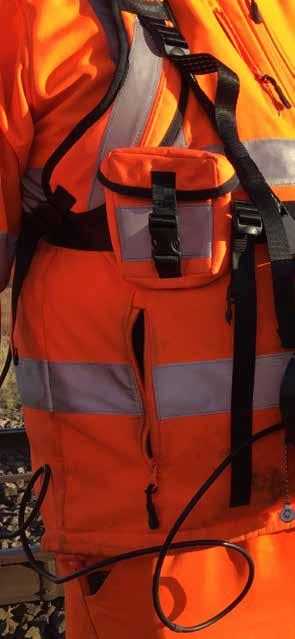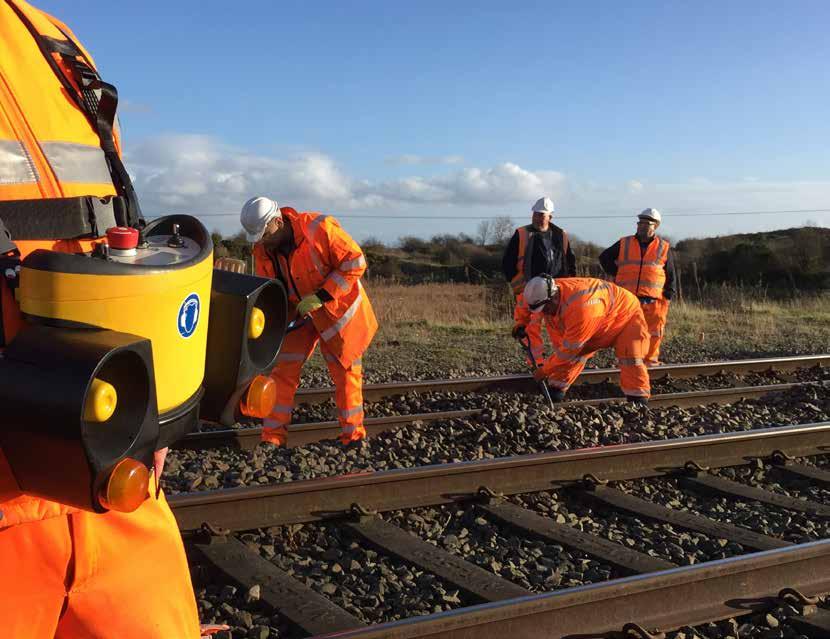
8 minute read
TASKED TO IMPROVE
WHEN NETWORK RAIL WAS SERVED WITH A SAFETY IMPROVEMENT NOTICE, IT CREATED A TASK FORCE TO MANAGE ITS RESPONSE. ITS LEADER, NICK MILLINGTON, RECENTLY
Nick Millington.
SPOKE WITH RAILSTAFF'S COLIN WHEELER
In the May/June edition, under the heading of “Safety to improve from July 2022?”, I referred to Network Rail’s response to an Improvement Notice served on them last year by the Office of
Rail and Road. This stated that “they have not ensured that appropriate procedures are in place, and suitable equipment is provided, for preventing a person working on the transport system from being struck by a moving train”.
At the time, I expressed disappointment with the notice’s compliance date of July 2022 in the light of the most recent fatality, near misses and other incidents, suggesting that earlier improvements were needed. The date was set by ORR, but Network Rail felt I was suggesting things were moving too slowly.

Safety Task Force
In response, I was offered, and was pleased to accept, a virtual meeting with Nick Millington, who leads the Safety Task Force managing the Network Rail response to the Improvement Notice. I thank Nick for finding the time to appraise me of the work done so far to address the shortcomings.
Progress has clearly been made, and I now know a little more.
In the May/June article, I referred to the £70 million of Task Force initiatives to be implemented. The Task Force is made up of more than 100 full-time staff, whose job is to pull together and make “5,200 milestone changes”. It was set up before the Margam fatalities.
Members include safety professionals, work deliverers, and individual teams from the 13 routes and five regions. I was told that 25 per cent of the members are front line supervisors and section managers, which is encouraging.


Staff involvement?
As I understand it, the involvement of “staff members” (i.e. trackworkers) and, especially, agency workers, is so far very limited and, for the latter, yet to be pursued. A request for staff views and ideas was issued, but that process was subsequently paused due to the Covid-19 pandemic.
During the short time that it was open, it generated an encouraging 15 proposals for changing current practices to improve safety. I have been told that this process will reopen “soon”. I hope it will move on to include individuals working for contractors, subcontractors and those used by agencies organising zero-hours contracts, as referred to in the RAIB (Rail Accident Investigation Branch) annual report for 2019.
Trades Unions to back risk reduction?
Equally important is the support of relevant trades unions. At first sight, we might assume it would be easy for every one of them to commit 100 per cent. However, although new skills and jobs will emerge, the progressive elimination of employment to carry horns or whistles, together with red, green and even distant lookout chequered flags, needs to be concluded before July 2022 at the latest.
Historically, we know that the work of a lookout is hazardous in itself. To date, I was advised that “unassisted” lookout working had been reduced by 55 per cent in April, with total replacement in Scotland, a reduction to just five per cent on LNE/East Coast and reductions of between 20 and 25 per cent on North Western, Central and Southern.
Some redeployment may result, but will be in the best interest of everyone. Which will be the first union to back changes that will improve track worker safety and press Network Rail to get on with it?
Ballast-scratched boots
I am reminded of a comment made by a number of respected rail engineers that “the person with the shovel and ballast-scratched boots knows both the questions and many of the answers – all we need to do is ask him or her the questions”. Which of the rail unions will be first to endorse a policy eliminating the use of lookouts, assisted or not?
Such a move would surely be seen as supporting the future safety of their members. Better planning, workforce involvement and the creation of a real safety-first culture motivating each and every person with a valid personal track safety card is more important than any of the systems, rules and technology.
Technology and line blockages
The Task Force has been looking at using technology to assist in the use of line blockages and protection. The number of line blockages now being taken using additional protection has quadrupled. Some 90 of Network Rail’s 700 signaller workstations are collecting data about the use of line blockage methods. The objective is the provision of additional protection to reduce the risks from human error.

I admit to being surprised to learn that the automatic track warning systems that I knew about when I was still working full time, made by Schweizer and Zollner, are still being evaluated! As long ago as 2011, there was a ‘Track Warning Systems Steering Group’ at work, so it surely cannot really be claimed that their introduction into regular use needs more time?
Intelligent infrastructure
Increasing the use of “intelligent infrastructure and remote monitoring” to reduce the need for working trackside is a listed objective which makes sense. The same may be said for using technology to assist with the provision of line blockages and staff protection when on or near the line.
Remotely activated TCODs (track circuit operating devices) have been available for some time. A few years ago, the Rail Media Annual Safety Conference was told of their

use in Europe and trial usage here. It has taken a few years, but I was pleased to learn that during the last twelve months some 500 have been installed in remote places.
An additional 361 devices have now been deployed and, by the end of 2020, this will rise to over 700. These pieces of kit are tried, tested and easily fitted by any trained member of track staff.
Discovery in next generation signalling
In the near future, we may hope to see the introduction of line blockages protected by the next generation of signalling systems with remotely activated track-circuit operating devices incorporated into them.
Existing signalling systems are nearing the end of their IT working lives. £16 million is earmarked for competitive quotations, for what is described as “a Discovery Phase” for the future. The aim is to identify each and every track access and equip them with swiping-in points. Each member of every work group will be required to individually swipe in.
Meanwhile, I was advised that some train manufacturers have developed, or are developing, systems that can be overlayed on existing SSI (Solid State Interlocking) signalling systems.
The Task Force is also using a rail hub system to develop schematic work site diagrams. Nick and I were able to talk about our past experience of using hand-drawn shift diagrams, which fulfilled the same purpose without the need for 40-page work plans.
Standard 019 and planning unneeded work
Network Rail standard 019 (NR/L2/OHS/019 – Safety of People at Work on or Near the Line) sets out the way in which work should be planned and delivered; and it is clear that 100 per cent compliance is needed.
I was pleased to hear that it is now accepted that the standard is too long, over complex and needs simplification and updating. I was also told that maintenance work banks need “sifting” so that unneeded work is no longer planned.
It is acknowledged that, although the specified “method of last resort” is working under lookout protection, this has not been followed in the past.
Version 8 of the standard was 40 pages long but it was followed by version 9, which had grown to 60 pages! Simplification is now the aim, with the objective of a standard of just 10 pages.
PICOWs to return?
Nick suggested simplifying the hierarchy of safety and work supervision by reintroducing a combined single PICOW (Person in charge of Work) role to replace COSS (Controllers of Site Safety). What a good idea! Individuals taking personal responsibility has to be the aim.
There are currently some 14,000 COSSs used by Network Rail and the current perceived duplication of roles remains a real concern as being unhelpful and risky.
Safe Work Packs
Safe Work Packs have often featured in RAIB reports that I have studied. I recall using supervisor and technical staff-friendly single-sheet hand-drafted shift diagrams which adequately fulfilled the same purpose decades ago.
The Task Force is introducing one-page SWPs (Safe Working Packs) for just seven key tasks that are straight forward in nature and do not need full details running to 40 pages. Packs are to be simplified, easy to read and reduced to save both time and paper.
Electronic SWPs are now being delivered and are proving popular. (I will never forget being told by a straight-faced COSS that all Method Statements should include the provision of an extra worker with a wheelbarrow, in which to carry all the safety paperwork including the voluminous Safe System of Work Pack!)
These words were in the title of my article published in the last edition of Railstaff. The changes in working patterns, and in particular rail commuting traffic, as a result of the switch to working from home due to the pandemic, provides us with an opportunity.
Politically, we expect changes to our rail services. I strongly advocate a programme of timetable changes to include regular no-train periods when inspections, condition monitoring and routine maintenance can be carried out (White Zone Working). The pandemic has provided us with the best possible opportunity to do so.
As Simon French’s 2019 RAIB report says, it works for French Railways, London Underground and the Docklands Light Railway, so why not here? If we fail to seize upon it right now, future track-working staff

will have good reason to resent the inevitable continuing incidents of people being struck by moving trains.
Above all, what is necessary is the generation of a total commitment to track safety in the hearts and minds of everyone who carries a current Personal Track Safety card and those who supervise and manage them.
WE DELIVER YOUR TRACK SAFETY SOLUTIONS

Get in touch with us!
tracksafety@zollner-uk.co.uk zoellner.de




